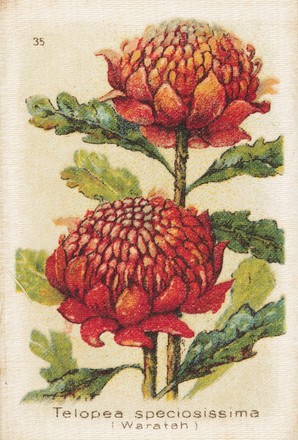Telopea speciosissima (Waratah) from Australian Wildflowers cigarette cards, 1913
Printed silk with paper backing
Presented by WD & HO Wills, Sydney 1916
581.99 / W
Cigarette cards were produced to stiffen
flimsy cigarette packaging and to advertise cigarette brands. Originally
produced as individual cards, they were produced in sets by the 1890s. This set
features 50 cards.
Most commonly made from paper, the cards were
also made from other materials such as silk, satin and lace. The images were
printed onto fabric with a paper backing often added to give rigidity.
Collectors were encouraged to make objects
for home decoration such as cushion covers from their silk cards.
Sarah Morley, 2015
In 1989 WD
& HO Wills (Australia) became a subsidiary of the British American Tobacco
Industries group of companies.
The
earliest cigarette cards were produced in North America in the late 1870s
Although most commonly made from paper, the
cards were also made from other materials such as silk, satin and lace. The
images were printed onto the silk with a paper backing often added to give
rigidity. Collectors were encouraged to make objects for home decoration such
as cushion covers from their silk cards, with manufacturer Godfrey Phillips
awarding prizes for the best objects. Paper
shortages during World War II halted card production.
Frank Doggett , Cigarette cards and novelties, 1981
Wills’
first set ‘Ships and Sailors’ was produced in 1895, followed by ‘Cricketers’ in
1896.
Popular
themes included sports (including football and cricket), stars of the stage and
screen, natural history (including flowers and butterflies), military and land,
sea and air. Numerous sets were produced with Australian content some with as
many as 100 cards.
WD & HO Wills (Australia)
Ltd began manufacturing tobacco products in Sydney in 1913.
In 1887, WD & HO Wills were the first
cigarette manufacturer in Britain to include advertising cards in their packs
of cigarettes.
Between World War I and II is
known as the golden age of cigarette cards. Although tobacco companies were in
decline, companies such as Wills remained committed to the production of new
series to collect. In 1936 they printed 600 million cards for their reissue of
Railway Engines.
Cigarette
cards were issued in sets, usually of 25 or 50, to encourage repeat purchases
and establish brand loyalty. They
became a major feature of the tobacco industry and an extremely successful
marketing tool.



 Back to list
Back to list